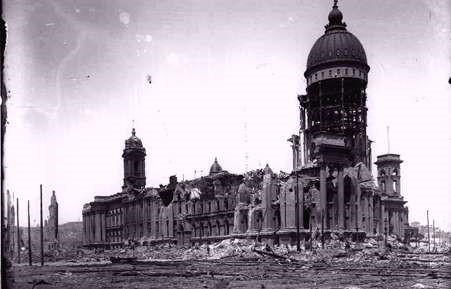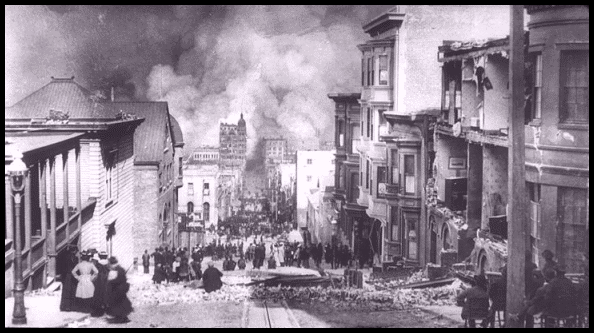Introduction


http://earthquake.usgs.gov/regional/nca/1906/18april/index.php
The California earthquake of April 18, 1906 ranks as one of the most significant earthquakes of all time. Rupturing the northernmost 296 miles (477 kilometers) of the San Andreas fault the earthquake confounded contemporary geologists with its large, horizontal displacements and great rupture length.
At almost precisely 5:12 a.m., local time, a foreshock occurred with sufficient force to be felt widely throughout the San Francisco Bay area. The great earthquake broke loose some 20 to 25 seconds later, with an epicenter near San Francisco. Violent shocks punctuated the strong shaking which lasted some 45 to 60 seconds. The earthquake was felt from southern Oregon to south of Los Angeles and inland as far as central Nevada.
One important characteristic of the shaking intensity noted in Lawson's (1908) report was the clear correlation of intensity with underlying geologic conditions.
In the public's mind, this earthquake is perhaps remembered most for the fire it spawned in San Francisco, giving it the somewhat misleading appellation of the "San Francisco earthquake". Shaking damage, however, was equally severe in many other places along the fault rupture. The frequently quoted value of 700 deaths caused by the earthquake and fire is now believed to underestimate the total loss of life by a factor of 3 or 4. Most of the fatalities occurred in San Francisco, and 189 were reported elsewhere.
Task
Grades 3 & 4
Students please get in groups of 4 (even numbers) and I would like for you to be able to describe and mimic the duration, displacement, and type of movement along the fault that produced the 1906 earthquake.
Content Objective: students will choose some of the characteristics of an earthquake and draw what happens during an earthquake.
Students will write a short story using the internet to help them with their earthquake story and write about what they saw happened.
Process
- Powerpoint (The Great Quake)
- Video: http://www.sciencekids.co.nz/videos/earth/whatisanearthquake.html
Ask the students the following questions;
- What force in nature might cause this destruction?
- Explain in your own words what you think a fault is?
- What force in nature might cause this destruction?
#1
The students will understand the process of movement on a fault by doing a physical demonstration of the movement of rocks along a fault. The class will be divided into two equal groups and they will need to form a single file line, representing a block of rock. They will be parallel to the rope (fault) in the middle of them. They will need to stand shoulder to shoulder facing their classmates across the fault line. They will need to place their palms of their hands outward, in front of them, touching their peers’ palms. This will represent the ground before the earthquake.
The students are able to shout “earthquake!” and release their energy by moving. They can slide to the left and can jump up and down. I will walk the students through what is happening using slow motion. They will remain in motion for 50 seconds (the duration of the 1906 earthquake) and continue until they are approximately 6 m apart.
Safety Precautions:
Care should be used when doing the physical activity. Students will need to avoid bumping into their classmates and must contain a controlled behavior when participating in the physical activity.
#2
After participating in the activity, as a class, we will discuss the key points: blocks of rocks—students slide past each other along a fault line (rope); as the blocks move they release energy (demonstrated as motion) in the form of an earthquake; and during great earthquakes the ground might shake many tens of seconds and move 10-20 m. We will return to the pictures that show clear examples of the ground on each side of a fault line. I will ask the students to make observations about what types of human-made things were also moved when the ground along the fault line.
#3
Students will be required to write down important characteristics that happened during the activity section. I would like them to write as if they were there to see what was happening during the earthquake. They can also write important things that changed when they saw on the before and after photos of the Great Quake of 1906. After writing a few sentences about the earthquake, students are able to draw a picture of the activity and name the diagram.
Evaluation
This is what I will be looking for to grade the students on their understanding of earthquakes:
Students will be required to write down important characteristics that happened during the activity section. I would like them to write as if they were there to see what was happening during the earthquake.(Students are able to use computers to do more research on the Earthquake that happened in 1906.) They can also write important things that changed when they saw on the before and after photos of the Great Quake of 1906. After writing a few sentences about the earthquake, students are able to draw a picture of the activity and name the diagram.
I would like to see atleast one thing they found while researching and I will be grading on how well they understand what happens during and after an earthquake.
Conclusion
After how ever long it takes for them to do research and complete their assignment, I would like to do presentations. As the teacher, I will begin with my presentation and tell them what I wrote about if I was there and what I drew. Presentations should be less than 5 minutes, depending on how long they would like to speak about their project.:)
Credits
http://www.sciencekids.co.nz/videos/earth/whatisanearthquake.html
Mo SPE Standard # 1, 2 & 3
Show Me Standard #2 and 5